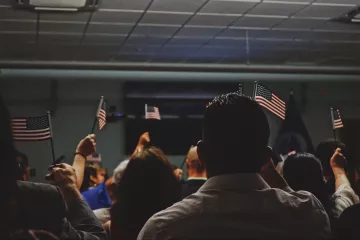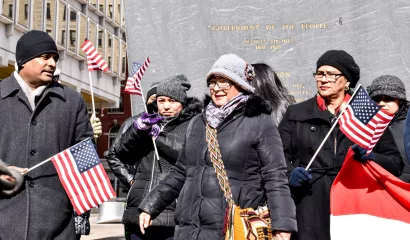- | International Freedom and Trade International Freedom and Trade
- | Policy Briefs Policy Briefs
- |
Attracting Global Talent to Ensure America Is First in Innovation
Politicians of all stripes are always looking for ways to grow our economy, strengthen the labor market, and increase our competitive advantage on the world stage. One of the ways in which these aims can be achieved is by allowing more temporary high-skilled foreign workers to fuel Americas growing services and technology sectors. Evidence suggests that for every temporary foreign worker hired by a US firm, 5 to 7.5 new domestic jobs are created in those industries, and that a 1 percent increase in foreign STEM workers leads to a 7 to 8 percent increase in native workers’ wages. Immigration reform for high-skilled foreign workers and talented foreign students would ensure that the United States continues to be the global leader for international talent, business growth and entrepreneurial innovation.
H-1B Visa
With the current administration pushing through significant reforms to the H-1B visa application process, policymakers should consider whether proposed changes are conducive to attracting global talent, or in fact, discouraging global talent from coming to the United States. High skilled immigration to the United States has been, for a long time, a fundamental driver of wealth and job creation. If we are to avoid losing an ever-greater pool of talent to other developed nations, then we need to ensure that our talent-based visa system continues to attract the best and brightest that the world has to offer.
The H-1B Visa program, created by Congress in 1990, has played a fundamental role in driving innovation and business growth in the United States for almost 30 years. The work-focused visa allows US companies to hire high-skilled workers, predominantly in the IT and tech sectors. Under the H-1B program, 65,000 new visas are issued every year, with an additional 20,000 available to workers with a US master's degree or higher. These temporary visas last for 3 years, with the option of an additional 3-year extension.
The economic benefits of the H-1B visa program are not only felt by the immigrants themselves—the resulting boost to investment and innovation creates significant opportunities for Americans. Recent research has demonstrated that H-1B immigrants to the United States tend to generate more patentable technologies than natives: though they constitute only 18 percent of the 25 and older workforce, immigrants obtain 28 percent of high-quality patents. Other research examining short-run fluctuations in the number of H-1B visas similarly concludes that immigrants add to aggregate innovation. The greater number of patents contribute to productivity gains for American workers. The more productive American workers become, the more their wages are likely to rise.
Welcoming global talent to the US not only drives greater innovation, but also creates more jobs and higher wages for Americans. H-1B workers are often in key positions within a business or firm, so their skills are essential for company growth. In fact, research shows that technology companies create 5 new domestic jobs for every H-1B visa they successfully sponsor—for tech firms with fewer than 5,000 workers, each H-1B position requested was associated with an increase in domestic employment of 7.5 workers.
The technology industry is not the only sector of the economy to benefit from the growth effects of skilled immigrants who tend to perform roles as gap fillers and specialists. The audit industry employs a large number of highly skilled foreign workers for specialty occupations, with roughly 83 percent of audit offices employing individuals who hold H-1B visas. A study published in the journal Management Science found that from 2001-2012, the six largest public accounting firms hired 55,000 H-1B visa holders. In 2012 alone, employees with H-1B visas contributed 28 percent of the growth of assurance business human capital.
Academic research has also demonstrated that H-1B visa holders actually increase the wages of Americans. One study revealed, “that a rise in the growth of foreign STEM by one percentage point of total employment increases growth in the wages of native college educated workers by a statistically significant 7-8 percentage points.”
Even though the empirical analysis demonstrates the economic opportunities that the H-1B visa program has brought to the United States since its inception, the program has become noticeably more restrictive in recent years. Historically, H-1B approval rates have fluctuated between 75 percent and 87 percent since 2007; however, in 2017 the percent of H-1B applications, that were approved fell to just 59 percent.
The U.S. Citizenship and Immigration Services (USCIS) agency received 190,098 H-1B applications for fiscal year 2018, a 4 percent drop from 2017, when 199,000 applications were filed. It is also a sharp decline from its peak in 2016, when the government received 236,000 applications. The dramatic increase in denials and Requests for Evidence (RFE) is evidently having a negative effect on the number of high skilled workers applying for H-1B visas.
F-1 Visa
A second visa program which attracts global talent to the United States is the F-1 visa program, or student visa. The F-1 visa is an education-focused visa, which like the H-1B program, attracts the best and brightest of global talent.
There are a total of 1,094,792 international students studying at U.S. colleges and universities in 2018, representing roughly 1 in 20 college students. These international students contributed $39 billion and supported more than 455,000 jobs to the U.S. economy during the 2017-2018 academic year.
Based on these figures, for every dozen international students who chose to study in the US, 5 domestic jobs are created either directly or indirectly, and the US economy benefits from additional spending of $427,500. The F-1 Visa program is particularly beneficial to states such as California, Florida, Illinois, Indiana, Massachusetts, Michigan, New York, Ohio, Pennsylvania, and Texas, all of whom benefited from an inflow of more than $1 billion in 2017-18 and tens of thousands of jobs.
Among full-time graduate students in the U.S., 81% of students in electrical engineering and 79% in computer science are international students. A 2010 study on the impact of graduate immigrants on innovation levels found that every 1 percentage point increase in college graduate immigrants as a share of the population increases patents per capita by 9 to 18 percent — a tremendous increase.
Upon graduation, many of these international students enroll in the Optional Practical Training program (OPT) and some go on to secure H-1B sponsorship from their prospective employers. In fact, among traditional immigration destination countries (USA, Canada and Australia) there is a well-established relationship between graduated foreign students and their integration into the labor market after completion of studies. Approximately, 15-35% of international students can be expected eventually to work and settle in their host countries; the higher the level of education, the more graduates stay.
A study from 2011 found that immigrants who originally entered the United States on student/trainee visas outperform native college graduates in wages, patenting, commercializing and licensing patents and authoring books or papers for publication. The same study also found that, conditional on education, these immigrants are more likely than natives to start a successful company as they tend to have a niche in start– ups based on technical knowledge from master’s and doctoral degrees.
The number of new international students attending American colleges and universities in 2017/18 dropped for the second straight year. The number of new students dropped to about 271,000, from about 291,000 in 2016/17 and around 301,000 in 2015/16. Immigration policy experts and college administrators attribute the decline to the current administration’s drive to restrict immigration and an overall sense of a U.S. political climate that is hostile to immigrants and foreigners.
Raise the Cap to Avoid Stifling Innovation and Investment
Policymakers should look to the immigration advances of our neighbors north of the border before enacting reforms to U.S. immigrant visas. In recent years, Canada has been liberalizing its high-skilled immigration visa system. At 172,500 skilled work visas issued annually, that is more than double the number issued in the US, at a rate per capita for high-skilled workers that is 7 times higher than that of the United States. In 2017, Prime Minister Justin Trudeau launched the fast-track Global Skills Strategy programme which processes visa applications in just two weeks; compared to the USCIS processing time of six to seven months, or longer. Canada is increasingly becoming the preferred destination for high-skilled talent in areas such as engineering, software development and medical services. In short, with the liberalization of high-skilled immigrant visas in countries such as neighboring Canada, and increased stringency here in the U.S., the United States is losing in the global competition for international talent and entrepreneurial innovation.
In order to avoid stifling the great innovations and financial investment in the United States that comes with having a highly skilled migrant labor force, the existing H-1B program will need to expand its tight cap of 85,000 visas. The number of existing visas under the H-1B program represents less than half the demand for H-1B visas in 2018. Last year US companies filed 190,098 applications for H-1B workers, the maximum allocated number of H-1B visas under the current lottery system represents just 42 percent of the number of visas demanded by US employers.
In order to meet demand, the cap should be revised to ensure that supply closely follows demand for high skilled international workers. Adjusting the existing base cap allocation of 65,000 to the rate of 115,000 under a “market-based escalator” system would more closely align supply with demand. This allocation level would also reflect the number of H-1B visas allocated in 1999 and 2000 under the American Competitiveness and Workforce Improvement Act (ACWIA), when policymakers acted upon increasing demand for high-skilled workers. Uncapping the existing cap for holders of US Master’s Degrees or higher would allow the most talented graduates to apply for Change of Status (COS) from the F-1 visa program. The upper limit cap could be set at 195,000 as it was from 2001-2003 under the American Competitiveness in the 21st Century Act (AC21) when policymakers recognized that the H-1B visa quota was heavily oversubscribed. Under such a system, the total number of H-1B visas allocated each year would amount to between 115,000 and 195,000, depending on the number of applications from holders of US Masters Degrees or above.
Conclusion
H-1B visas have played a fundamental role in driving innovation and business growth in the United States since the program’s inception in 1990. The number of annual visa allocations is currently fixed at an arbitrarily low number. A market-based escalator system of visa allocations would more closely match demand for high skilled workers with the supply of available visas. The increased opportunities for international students to apply for COS and enroll in the H-1B lottery would slow the flow of US trained professionals leaving the country. These reforms would ensure that the United States continues to be the global leader for international talent, business growth and entrepreneurial innovation.



